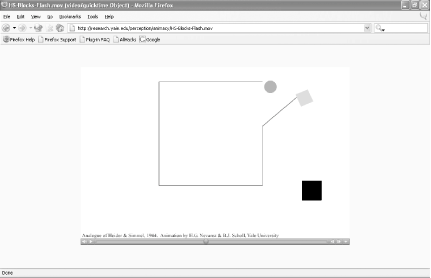Hack78.Make Things Come Alive
|
Hack 78. Make Things Come Alive
Add a few tweaks to the way a thing moves, and you can make objects seem as if they have a life of their own. Sometimes, when there isn't evidence of causation, your perceptual system detects self-causation and delivers up an impression of animacythat quality of having active purpose that makes objects seem alive. Animacy is simultaneously easy to see but hard to think about, and both for the same reason. We have evolved to live in a world of animals and objects. But living things are more difficult and more dangerous than objects, so our minds are biased in lots of ways to detect agencythings happening because someone or something wanted them to happen for a purpose (better to assume something happened for a reason than to ignore it completely, right?). This specialization for making sense of agency means we're disposed to detect it even if it isn't strictly thereit is natural for us to use the language of intentions to describe events when there are no intentions. If you say that water "wants" to find the quickest way down the mountain, people understand you far easier than if you start talking about energy minimization, even though the water doesn't strictly "want" anything. It's natural to feel as if your computer hates you, just as it is natural to feel that people are deliberately making things hard for you,1 when the sad fact is that most people probably aren't spending too much time thinking about you at all, and your computer certainly isn't thinking about you. We can take advantage of our disposition to detect agency in objects, making them appear to be alive by adding just a few simple characteristics to the way they move. 8.5.1. In ActionOne way of showing that something is pretty psychologically fundamental is to show that children do it. As soon as children can see, they expect to find animate objects in their environment and prefer to watch them than simple moving objects.2 So we'll show how fundamental it is to perceive animate objects by showing some movement to a young kid and seeing how he interprets it. Of course, you'll need a young kid to try this on, the younger the better, as long as he can understand and answer your questions.
Get two objects: it doesn't really matter what they are as long as they definitely aren't alive and don't look remotely like anything aliveit will help if they are different sizes; two rocks or wooden building blocks will work rather nicely. Put the two objects on a table and ask the child to pay attention to what you're about to do. Move the bigger object slowly toward the smaller. When they're within 2 inches of each other, move the small object very quickly to another part of the table. Immediately, have the large object change direction and head toward the new location of the small object. The large object always moves slowly toward wherever the small object is; the small object always stays at least 2 inches away. Now, ask the child "What's happening here?" It should be obvious to you from reading this description, and it will be obvious to the child, that the large object is trying to catch the small object. Just from physical movements the child will infer a guiding purpose and attach it to some kind of inner belief that is a property of the objects ("the large rock wants to catch the small rock"). He could just as easily say "You are moving the rocks around in a funny way," but he probably won't. He prefers the explanation that involves the rocks having intentions. 8.5.2. How It WorksThe first experiments with animation involved movies of three simple shapes, two triangles and a circle, moving around a large rectangle. You can see something similar in the moving squares and circles by Heider and Simmel (http://research.yale.edu/perception/animacy/HS-Blocks-Flash.mov; QuickTime), a frame of which is shown in Figure 8-6.3 Figure 8-6. Notice how the static display offers no clues at all that the shapes are in any way animate Regardless of what they were told to pay attention to, people who watched the movie attributed personality traits and emotions to the geometric figures. The shapes act alive, and you can't avoid thinking about them in those terms. So what do simple objects have to do to look alive? The first, and most obvious, thing is to move on their own and to move in ways that seem self-caused. Changes in direction and velocity help.4
If the shapes have an obvious "front" end to them and move along their main axis, that helps too. You can see this effect in a replication of the first movie, but with arrowheaded shapes at http://research.yale.edu/perception/animacy/HS-Darts-Flash.mov. Shapes that follow goals and interact with their environment (pushing against things or swerving to avoid objects, for instance) also seem more alive. It isn't so important that the viewer can see the thing that is the goal of the objectmerely acting to follow something is sufficient to create the impression of animacy. This last fact does make a kind of sense; one of the reasons our visual system has evolved to detect intention is not just to recognize it, but to predict what the purpose of someone or something's movement is. You may not know what a person is throwing rocks at, but the fact that you interpret their movements as "throwing rocks at something" means you will look for a target and that will increase your chance of finding out what it is. 8.5.3. End Notes
|
|
EAN: N/A
Pages: 159
